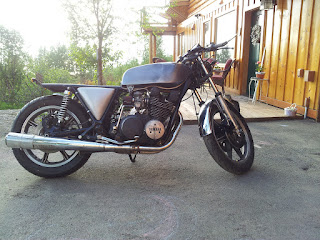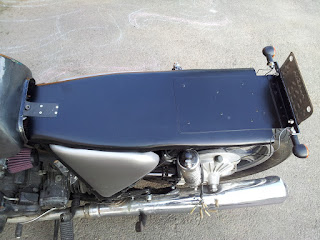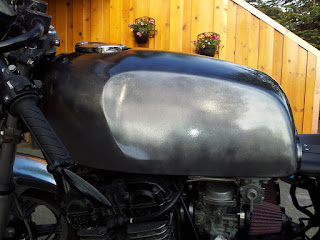First, I CANNOT get the <many, many expletives deleted> LH front brake to quit leaking. I've tried crush washers, epoxy, and I even tried solder today to keep the brake fluid from weeping around the threads of the screw that I'm using to fill the bleeder hole, but nothing works. However, I came up with an ingenious solution, I think: remove the LH brake entirely. The rear brakes work and the RH front brake isn't leaking (knock on wood!) after filling the bleeder hole with epoxy, so I removed the LH brake. I'll see if I can find someone with a TIG welder to fill the bleeder hole with aluminum, but until then, I'm going to try having only one front brake.


Next, I needed to finish up the wiring on the rear of the bike, so after pulling the LH front brake, I set out to get the tail light/brake light and turn signals wired up. Unfortunately, I discovered two problems, once the wiring was done: the turn signals don't flash, and the front turn signals wouldn't light up at all. The flashing I understand, and the solution was (well..."will be") simple. The new turn signals don't draw as much current as the old turn signals, so I need a solid-state flasher. I had already bought a flasher to use with LED-based turn signals, but it wasn't compatible with my wiring harness. I didn't feel like wiring up a new harness, so instead, I went back to Superbright LEDs and ordered a compatible (I hope...) flasher. The second problem is proving to be a little more difficult to resolve. After poking around the wiring inside the headlamp housing for a bit, I discovered that the filament on one of the turn signals had broken. Remember, these are brand new turn signals, and when I originally bought them, I tried to remove the lamp to install an LED in its place, but failed. Having nothing to lose, I tried again to remove the lamp, this time being a little more aggressive, and I was, in fact, successful. Unfortunately, my local auto parts supplier didn't have a match for the tiny little bulb that was installed in the turn signal. Fortunately, Superbright LEDs had what I think is a match, so I will be replacing the bulbs with LEDs after all. My opinions on that are somewhat mixed, though. I wanted LEDs in the first place, but sheesh...I've never even used the friggin' turn signals and I'm already replacing bulbs(!). Honestly...I'm a bit torqued over it.
I also need to finish the seat before I can ride the bike, so I set out to remedy that problem, too. Originally, I intended to build something like a flat-tracker seat, which would allow me to carry a passenger. Then, I wanted to make a fiberglass solo cowl shaped like the archetypal cafe racer "hump" which I could install when I was by myself. However, relocating the license plate and lights above the seat pan changed my plans slightly. I decided to build a very small cowl that was more or less similar to the cowl that was originally installed on the bike, and possibly make a truncated cafe racer "hump" to fit over the vestigial cowl when I'm riding solo. To make the minimalist cowl, I used the same process I used to make the side covers:
Glue blocks of foam together with spray adhesive, and test fit on the back of the seat pan. Mark the outline of the license plate and tail lights with a Sharpie.
Lay out the shape of the front of the cowl. I used the old trick of marking evenly spaced dots along the vertical edge of the foam blocks, then an equal number of evenly spaced dots across the top edge of the blocks, and finally drawing straight lines to connect the dots on the sides to the dots along the top to approximate a curve. It worked beautifully, IMHO :)
Cut and sand to shape...
...cover with blue painter's tape...
...and paste wax to act as a release agent, then glass it up. I didn't shoot a photo of the first layer of glass, but I'll try to get some shots tomorrow or Monday, when I add another couple of layers (since this hump will be acting as a back rest for the passenger, I'll be using more layers of glass than the I used on the side covers to make it stiffer and stronger).
Finally, I started going through the bike, making some of the adjustments called out in the maintenance schedule, like adjusting the clutch and clutch cable, checking and adjusting throttle cable play, adjusting the idle setting (which I believe I mentioned earlier), etc. This fixed a problem I had noticed before firing up the engine the first time: pulling the clutch lever didn't seem to fully release the transmission. I couldn't move the bike in gear, even though I was pulling on the clutch for all I was worth.
Oh, yeah...one last issue. The starter button is 100% inop. I don't know if I really care, however, since I'd already considered removing the starter entirely. It's extra weight and necessitates a larger, more powerful (read: heavier) battery. On the flip side, it must have taken me 15 to 20 minutes to get it started the first time, lol. It's been better since then, but still nowhere near as easy to start as the push-button V-Strom :D For now, I'll probably ignore the problem with the starter button, but leave the starter motor in place. If I find that kick-starting the bike all the time is no big deal, I may look into pulling the starter and putting in a smaller battery next winter. If I'm fed up with kick-starting the bike this summer, on the other hand, I'll troubleshoot the starter button and leave the starter motor in place.
All in all, it was a good day, and I'm getting ever closer to taking the bike out for a spin. Man, I can't wait!









